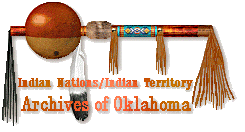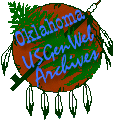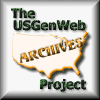
 |
Pontotoc County |
 |
|
Home |
Archives
|Towns
| Cemeteries|
Marriages |
Queries | Photos |
Schools |
Obits | Links |
Resources |
||
"Links to web sites that are not part of the USGenWeb Project are provided for your convenience and do not imply any endorsement of the web sites or their contents by The USGenWeb Project."
William L. COCHRAN
Remembering Stonewall, Pontotoc County, Chickasaw Nation
by Bill Tinsley
When the Civil War ended, the people of the Chickasaw Nation faced the gigantic task of rebuilding their homeland. The returning veterans and refugees found that the area around old Pontotoc, located in the northeastern part closer to the Indian Territory battlefields, had suffered more damage from the war than other parts of the nation. The surrounding countryside received heavy damage from a Union army invasion in 1864. Many of the homes and other buildings were burned, food supplies were destroyed, and livestock were stolen or driven off. The men returning home from the war were hard pressed to furnish their families with the necessities of life. It was some ten years before conditions in the Chickasaw Nation returned to anything like the people had know before the war. It was during that period that Stonewall came into existence.
William L. COCHRAN came to Pontotoc in 1868 and made an effort to reopen the trading post of his uncle, Robert L. Cochran. However by 1869 it was closed and the post office discontinued, and old Pontotoc passed into oblivion. In 1868 Aaron HARLAN and C.C. ROOKS came to the banks of Clear Boggy Creek and built a store one and one-half miles east of the Cochran Trading Post. They put in a small stock of goods, and Stonewall had its first business establishment. The log building consisted of two rooms, one of which Rooks and his wife used as living quarters. However, he later built a large frame home across the road from the store. Andrew J. HARDEN hauled the first load of logs for the store building from Leader Creek, and his father, W. R. Harden, did the masonry work. Harlan lived in the Choctaw Nation at that time, and Rooks managed the Stonewall store. James J. MCALESTER, founder of McAlester, Oklahoma, was employed as a clerk for Harlan and Rooks in 1869.
Thomas J. PHILLIPS also was associated with the store. He first worked as a clerk, then possibly became a partner with Harlan and Rooks, or he could have purchased the business. Whatever his status, Phillips was managing the store when he became the first postmaster of Stonewall on December 30, 1874. C.C. Rooks was connected with the store a gain when he became postmaster of Stonewall on January 11, 1878. Phillips sold his business interests in Pontotoc County about that time and moved to McAlester.
B.F. BYRD and J.M. PERRY purchased the old store and operated it for four or five years before selling out to W. L . COCHRAN in 1887. Charles S. SMITH was hired in 1883 as a helper in the store. The owners were so pleased with his work that in a few days he was given the management of the business. Smith remained manager after Cochran purchased the store. However, he quit the business in 1900 and moved away from Stonewall. Nicholas (Nick) HEARD later became Cochran's store manager, and he continued in that capacity after the store was moved to new Stonewall.
Immediately following the end of the Civil War, the Chickasaw people turned
their attention to restoring their educational system. In 1870 John TURNBULL,
chairman of the school committe of the Chickasaw Nation, files a report that
listed twelve schools in operation in the nation, including Colbert Institute.
The buildings at the old institute had been partially destroyed during the
war. They were repaired to the extent that classes could be conducted and
Joshua Hightower was placed in charge of the school in 1868. He remained
for only a short time, and George W. BRADLEY became superintendent of Colbert
Institute soon after he came to Pontotoc in 1869. Colbert A. BURRIS was in
charge of the boarding house, while his wife, Laura Burris taught at the
school. Bradley remained in charge Colbert Institute until it was again destroyed
by fire. The dormitory building burned in 1874 and the education building
in 1880.
With Colbert Institute no longer in existence, it became obvious that a new
boarding school was needed in the area. Through the efforts of Judson D.
COLLINS and Humphrey COLBERT, Collins Institute was built about one and one-half
miles southwest of the former school site. The institute was named in his
honor.
On September 29, 1887, Chickasaw governor W. H. GUY signed an act passed
by the legislature to establish the boarding house institution. The Collins
Institute would be a manual labor school for boys.
 |

God Bless America
OKGenWeb State Coordinator
Linda
Simpson
Asst: Mel Owings
© 1996-Present ~ All Rights Reserved
| USGenNWeb NOTICE: In keeping with our policy of providing free Information on the Internet, data may be used by non-commercial entities, as long as this message remains on all copied material. These electronic pages may NOT be reproduced in any format for profit or for presentation by other persons or organizations. Files may be printed or copied for Personal use only. Persons or organizations desiring to use this material for purposes other than stated above must obtain the written consent of the file contributor. |



